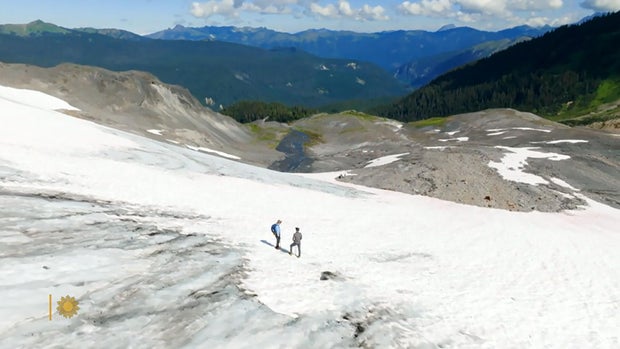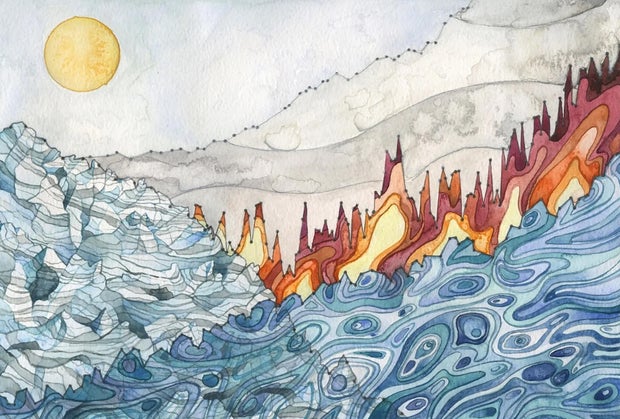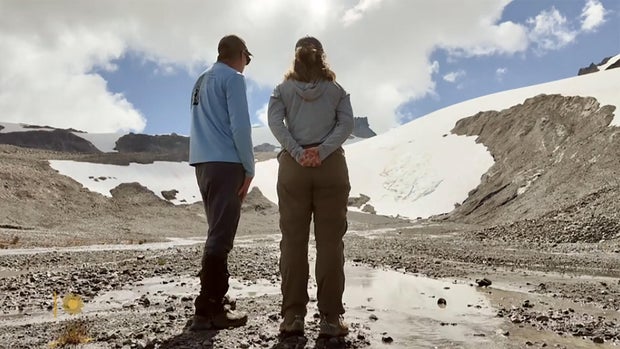Capturing the melting of glaciers, with data and art

In the rugged North Cascade Mountains of Washington State, no one likely knows this glacier better than Mauri Pelto, who says, "My life has been shaped by this ice."
For more than 40 years, Pelto, a glaciologist and a professor at Nichols College in Massachusetts, has returned to this remote wilderness. "We got 6,000 measurements on this glacier," he said.
Today, the crunch of footsteps in the snow is now rivaled by the sound of melting ice. "It's always melting off," he said. "The crevasses are changing. We can hear the water flowing under our feet."
Pelto founded the North Cascade Glacier Climate Project as a grad student in 1984. He vowed to measure these glaciers every summer for 50 years. This is Year 42. In that time the glaciers have changed more than he has, shrinking by 40%. Some have disappeared.
Pelto's work has been featured by NASA, and fed into a worldwide glacier database. Of the 47 glaciers he has studied, returning to them year after year, he says 12 are now gone, "nine of them just in the last five years."
Climate scientists say warmer summers and drier winters, driven by our burning of fossil fuels, are accelerating the loss. Seven of the 10 worst years for glacier melt worldwide have happened since 2010, according to Climate Central.
Or just ask Mauri Pelto where the ice used to be. "Almost 50 feet above my head just a decade ago," he said.

Glaciers are Earth's water towers, storing 70% of the freshwater supply, vital for drinking, farming, and the health of many ecosystems. As they melt, sea levels are rising, and coastal flooding is getting worse.
During his annual treks to the North Cascades, Pelto has hiked nearly 6,000 miles, and slept 800 nights in a tent. "We got our picture window," he said of the view. "It's also one of those places that's really special to us as a family."
His son Ben, daughter Jill, and now his nine-month-old granddaughter Wren have joined him in the field.
Jill Pelto has spent 17 summers by her dad's side, but she doesn't just collect data. As the project's art director, she paints it. The data points that she and her dad measure eventually will go into her art. "Data is a story about something in the real world and that story has meaning and emotion," she said. "And that's what I'm trying to bring into my art."
Her watercolor paintings are more than just beautiful landscapes; they reveal the science. Look closely and you see a bar graph of glacier decline in the North Cascades. One piece showing temperature rise and ice loss made the cover of Time magazine.

Jill said, "I think sometimes when people see data there's this instant reaction, and so it's not like the data is any different in my art, but something about that combination maybe gets people to kind of put down the wall of like, 'Oh, I can't understand this,' or 'You know, this is not something I'm interested in.'"
I said, "The average person is not going to read a scientific report, but they will see a painting. And it does impact you in a different way."
"Yes, definitely," said Jill.
Her art has given her dad a new way to share the story he's been recording for the past 42 years. And it's also changed their relationship: "We do it so seamlessly at this point," Mauri said.
"Feels like you're one team out here?" I asked.
"Yeah," he replied.
Jill added, "This bigger project just means so much to us and has shaped our lives. So, sharing that year after year is beyond special."
And now, Mauri Pelto has just eight summers left to fulfill his 50-year promise. Asked what he thinks it will be like to no longer come out to the glaciers, Mauri replied, "I don't know, I can't remember what it was like to not come out here. This landscape has been shaped by ice, and so to understand the landscape and the ice, you really have to walk across it."

For more info:
Story produced by Chris Spinder, in partnership with Climate Central. Editor: Chris Jolly.
See also:
Ben Tracy most recently served as CBS News' senior national and environmental correspondent, based in Los Angeles. He has reported for all CBS News platforms, including the "CBS Evening News," "CBS Mornings" and "CBS Sunday Morning."
Cbs News




